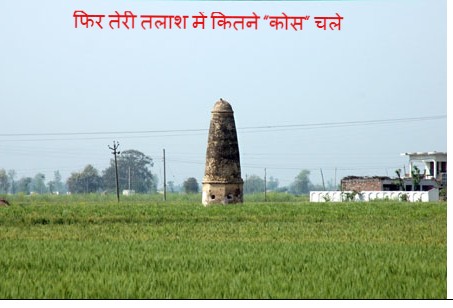A dying memory of Mughals era when distance measured with these Kos (Mile Pillars).
M4PNews|Chandigarh
While travelling in Punjab, you must have noticed these Minar type buildings standing tall in middle of farms or round the road corner. Some badly destructed and some holding shape. Ever wondered what are these, for what purpose, they could have been constructed. No?
These Minars are known as “KOS Minars”. It has a huge significance in our history, with our forefathers. Why?…Because, these had been the one through which used to signify travellers that how far they have reached and how far their destination left. Defining more here, Kos is an ancient Indian unit of distance. It can represent either a distance of approximately 1.8 km (1.1 mi) or 3.2 km (2.0 mi). Minar is a Persian word for tower.
Punjab has 6 Kos Minars namely Burj (Garhi), Sarai Amanat, Noordi, Bachere, Naurangabad and Bhorowal. (All have been rejuvenated now)
From the Corners of the Past

Kos Minars or Mile Pillars are medieval milestones that were made by the 16th-century Afghan Ruler Sher Shah Suri and later on by Mughal emperors. These Minars were erected by the Mughal Emperors on the main highways across the empire to mark the distance. The Kos Minar is a solid round pillar, around 30 feet in height that stands on a masonry platform built with bricks and plastered over with lime. Though not architecturally very impressive, being milestones, they were an important part of communication and travel in a large empire.

Kos Minars were used to mark the royal route from Agra to Ajmer via Jaipur in the west, from Agra to Lahore via Delhi in the north and from Agra to Mandu via Shivpuri in the south. Modern Indian highways have come up along roughly the same routes as those marked by these minars.
In an order to rejuvenate the existed Kos Minars in Punjab, with reference to Asian Development Bank’s (ADB) Fax on 26 September 2018 on the issue of access to the Kos Minar for civil work, the compliance report of observations on due diligence report (DDR) was submitted to ADB.
Suggested recommendations have been complied and accordingly DDR was revised. During discussion and consultation with the adjoined land owners, it was clearly informed that in case of any use of their agriculture land or in case of damage of crop, each affected person will be entitled for compensation and assistance as per approved entitlement matrix.
As now, after completion of civil work, again consultation with all the farmers and following points were noted:
- Land peace of all the Kos Minars are remains since its construction by Mughal Emperors’ and no enlargement has been done. Hence, no land issue rose.
- Due care has been taken during civil work and no construction activity took place near any crop field. The civil work has been completed during non-cropping period (Sep-Oct) only.
- Undertakings from each of adjoined owner have been obtained that no crop has been damaged during construction and civil work has carried out in open area only
According to a report of the Archeology Survey of India, there are 49 Kos Minars in Haryana. There are also five kos minars around Ludhiana city. Of late some of these Minars have been restored and attempts for preserving many others are online.
